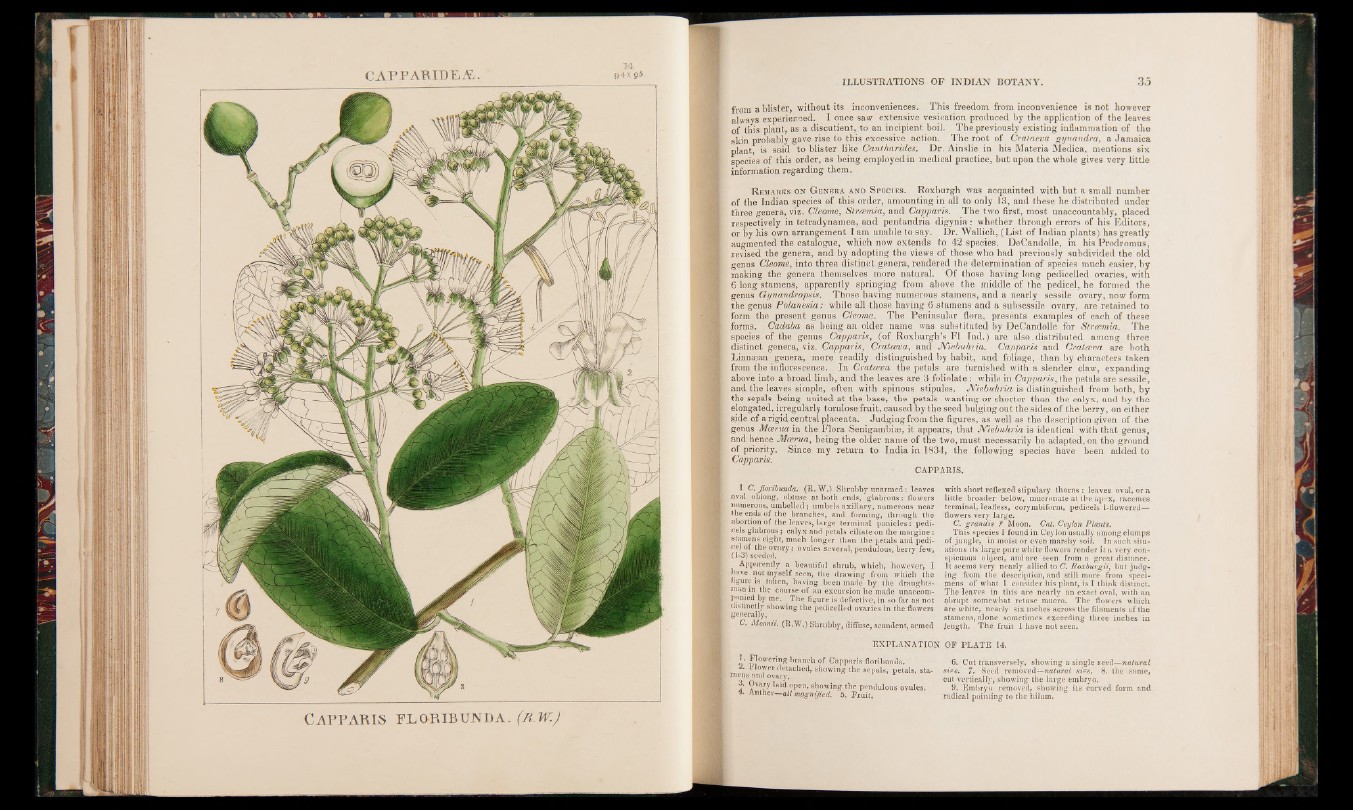
Capparis floribunda. (r .w.j
from a blister, without its inconveniences. This freedom from inconvenience is not however
always experienced. I once saw extensive vesication produced by the application of the leaves
of this plant, as a discutient, to an incipient boil. The previously existing inflammation of the
skin probably gave rise to this excessive action. The root of Crataeva gynandra, a Jamaica
plant, is said to blister like Cantharides. Dr. Ainslie in his Materia Medica, mentions six
species of this order, as being employed in medical practice, but upon the whole gives very little
information regarding them.
R emarks on G enera and S pecies. Roxburgh was acquainted with but a small number
of the Indian species of this order, amounting in all to only 13, and these he distributed under
three genera, viz. Cleome, Strcemia, and Capparis. The two first, most unaccountably, placed
respectively in tetradynamea, and pentandria digynia: whether through errors of his Editors,
or by his own arrangement I am unable to say. Dr. Wallich, (List of Indian plants) has greatly
augmented the catalogue, which now extends to 42 species. DeCandolle, in his Prodromus,
revised the genera, and by adopting the views of those who had previously subdivided the old
genus Cleome, into three distinct genera, rendered the determination of species much easier, by
making the genera themselves more natural. Of those having long pedicelled ovaries, with
6 long stamens, apparently springing from above the middle of the pedicel, he formed the
genus Gynandropsis. Those having numerous stamens, and a nearly sessile ovary, now form
the genus Polynesia; while all those having 6 stamens and a subsessile ovary, are retained to
form the present genus Cleome. The Peninsular flora, presents examples of each of these
forms. Cadaba as being an older name was substituted by DeCandolle for Strcemia. The
species of the genus Capparis, (of Roxburgh’s FI. Ind.) are also.distributed among three
distinct genera, viz. Capparis, Cratceva, and JYiebuhiia. Capparis and Cratceva are both
Linnsean genera, more readily distinguished by habit, and foliage, than by characters taken
from the inflorescence. In Cratceva the petals are furnished with a slender claw, expanding
above into a broad limb, and the leaves are 3 foliolate : while in Capparis, the petals are sessile,
and the leaves simple, often with spinous stipules. JYiebuhria is distinguished from both, by
the sepals being united at the base, the petals wanting or shorter than the calyx, and by the
elongated, irregularly torulose fruit, caused by the seed bulging out the sides of the berry, on either
side of a rigid central placenta. Judging from the figures, as well as the description given of the
genus Moerua in the Flora Senigambiee, it appears, that JYiebuhria is identical with that genus,
and hence Moerua, being the older name of the two, must, necessarily be adapted, on the ground
of priority. Since my return to India in 1834, the following species have been added to
Capparis,
CAPPARIS,
1 C. floribunda. (R. W.) Shrubby unarmed: leaves
£>val oblong, obtuse at both ends, glabrous: flowers
numerous, umbelled; umbels axillary, numerous near
the ends of the branches, and forming, through the
abortion of the leaves, large terminal panicles: pedicels
glabrous; calyx and petals ciliate on the margine:
stamens eight, much longer than the petals and pedicel
of the ovary: ovules several,pendulous,berry few,
(1-3) seeded.
Apparently a beautiful shrub, which, however, I
have not myself seen, the drawing from which the
figure is taken, having been made by the draughts-?
man in the course of an excursion he made unaccompanied
by me. The figure is defective, in so far as not
distinctly showing the pedicelled ovaries in the flowers
generally.
C, Moomi. (R.W.) Shrubby, diffuse, scandent, armed
with short reflexed stipulary thorns : leaves oval, or a
little broader below, mucronate at. the apex, racemes,
terminal, leafless, corymbiform, pedicels 1-flowered—
flowers very large.
C. grandis ? Moon. Cat. Ceylon Plants.
This species I found in Ceylon usually among clumps
of jungle, in moist or even marshy soil. In such situations
its large pure white flowers render it a very conspicuous
object, and are seen from a great distance.
It seems very nearly allied to C. Roxburgii, but judging
from the description, and still more from specimens
of what I consider his plant, is I think distinct.
The leaves in this are nearly an exact oval, with an
abrupt somewhat retu.se mucro. The flowers which
are white, nearly six inches across the filaments of the
stamens, alone sometimes exceeding three inches in
length. The fruit I have not seen,
EXPLANATION OP PLATE 14.
i o ’ J )ower’nff braneb of Capparis floribunda.
■ * lower detached, showing the sepals, petals, sta<-
piens and ovary.
3. Ovary laid open, showing the pendulous ovules,
% Anther—all magnified. 5, Fruit,
6. Cut transversely, showing a single seed—natural
size. 7. Seed removed—natural size. 8. the same,
cut vertically, showing the large embryo.
9. Embryo removed, showing its curved form and
radical pointing to the hilum.